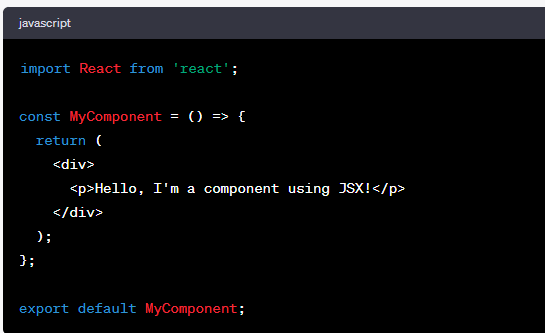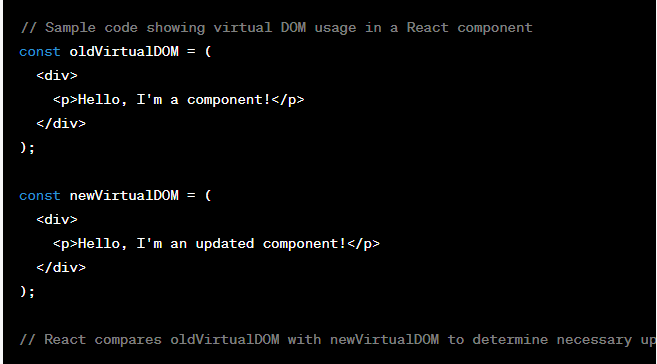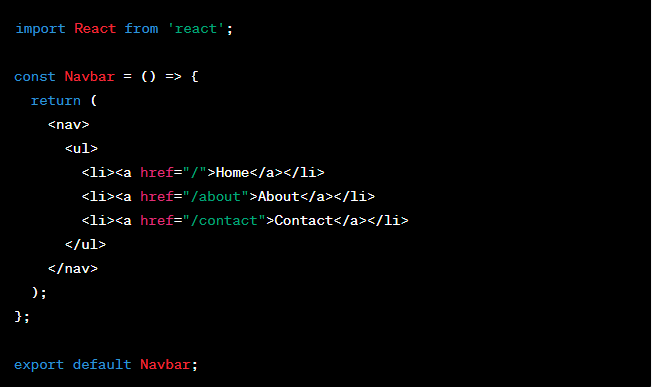Whether you’re envisioning a dynamic, responsive website or a sleek, feature-rich mobile application, React proves to be a versatile and efficient choice. In this blog, we’ll delve into the world of React, exploring its core concepts, advantages, and how it’s reshaping the way developers approach web and mobile development. Let’s embark on this journey to discover why React has become the cornerstone of contemporary app and website creation. In this blog post, we will learn about reach js benefits, uses and cost to create a website or mobile app using react js and native.
React JS Overview
React JS, often referred to as React, is an open-source JavaScript library developed and maintained by Facebook and a community of individual developers. It is utilized for building user interfaces, especially single-page applications where frequent updates and a seamless user experience are crucial.
Table of Contents
What is React JS?
At its core, React JS is designed to make the process of creating complex and interactive user interfaces more efficient. It employs a component-based architecture, allowing developers to create encapsulated, reusable UI components that manage their own state and can be composed to build more complex applications. These components are then efficiently rendered using a Virtual DOM, which minimizes direct manipulation of the actual DOM and optimizes performance.
Relevance in Modern Web Development
- Efficient UI Development: React simplifies UI development through its component-based architecture, enabling developers to create modular, reusable, and maintainable UI components. This approach streamlines the development process, particularly for applications with intricate and dynamic interfaces.
- Declarative and Predictable: React adopts a declarative approach, allowing developers to describe the UI’s appearance and behaviour based on the application’s state. This makes it easier to reason about how the UI will look and behave for a given state, enhancing predictability and reducing bugs.
- Virtual DOM for Optimal Performance: React utilizes a Virtual DOM, a lightweight copy of the actual DOM, to efficiently update and render components. By minimizing direct DOM manipulation and optimizing updates, React significantly improves rendering performance, enhancing the user experience.
- Reusability and Composability: The component-based nature of React promotes reusability, making it easy to reuse components across the application. Components can be composed and nested to create complex UIs, allowing for a high degree of composability and code reuse.
- Strong Community and Ecosystem: React benefits from a vast and active developer community, contributing to a rich ecosystem of libraries, tools, and resources. This community support ensures continuous improvement, robust documentation, and a plethora of third-party solutions to extend React’s capabilities.
- React Native for Cross-Platform Development: React Native, an extension of React, allows for efficient cross-platform mobile app development. Developers can use React and JavaScript to create mobile applications for both iOS and Android platforms, maximizing code reuse and speeding up the development process.
- Backed by Facebook and Community-Driven: React is backed by Facebook, ensuring its continuous development and improvement. The open-source nature of React encourages community contributions, making it a collaborative effort driven by passionate developers worldwide.
React JS plays a pivotal role in modern web development by providing an efficient and developer-friendly approach to building interactive and performant user interfaces. Its focus on reusability, efficiency, and a strong community make it a top choice for developers aiming to create cutting-edge web applications.
Why React JS is so Popular?
React’s immense popularity can be attributed to a combination of its powerful features, developer-friendly characteristics, and the unique solutions it offers to challenges faced in web and mobile app development.
Here are several reasons why React has gained widespread popularity:
1. Component-Based Architecture:
React’s component-based architecture encourages building applications as a collection of isolated and reusable components. This promotes code reusability, simplifies maintenance, and allows for the efficient development of complex user interfaces.
2. Virtual DOM and Efficient Rendering:
React employs a Virtual DOM, a lightweight copy of the actual DOM. This enables efficient updates and rendering, minimizing direct manipulation of the DOM and resulting in improved performance and a smoother user experience.
3. Declarative UI and Predictable Behavior:
React uses a declarative approach, allowing developers to describe how the UI should look based on the application state. This leads to more predictable behavior, easier debugging, and increased efficiency in developing and maintaining the code.
4. JSX for HTML-like Syntax:
JSX, a syntax extension for JavaScript, allows developers to write HTML-like code within JavaScript. This improves code readability and facilitates the seamless integration of UI components.
5. Ease of Learning and Adoption:
React has a relatively shallow learning curve, making it accessible to developers with varying levels of experience. The straightforward documentation and abundant tutorials further ease the onboarding process.
6. Large and Active Community:
React has a vast and vibrant community of developers who actively contribute to its growth. This active community provides extensive support, valuable resources, and a wide range of libraries and tools to enhance development.
7. React Native for Cross-Platform Development:
React Native extends React’s capabilities to mobile app development, allowing developers to build cross-platform mobile applications using a single codebase. This approach significantly saves development time and resources.
8. Efficient State Management:
React’s one-way data flow and the ability to manage the state efficiently through properties and states simplify the management of complex applications, improving their stability and maintainability.
9. SEO-Friendly Applications:
React enables server-side rendering (SSR) and supports the creation of SEO-friendly applications, allowing search engines to easily crawl and index the content for improved visibility.
10. Strong Industry Adoption:
Many prominent companies and tech giants, including Facebook, Instagram, Airbnb, Uber, Netflix, and WhatsApp, use React in their applications. This adoption validates React’s capabilities and encourages its wider usage.
11. Flexibility and Ecosystem:
React’s flexibility to integrate with other libraries and frameworks allows developers to choose and customize their tech stack. Additionally, the rich ecosystem of libraries and tools further enhances its functionality and efficiency.
React’s popularity stems from its ability to simplify UI development, improve performance, provide a great developer experience, and adapt to the dynamic needs of modern web and mobile app development. Its community support, extensive ecosystem, and the benefits it offers make it a preferred choice for developers and organizations worldwide.
What is React JS?
React JS, commonly referred to as React, is an open-source JavaScript library used for building user interfaces (UIs) and web applications. It was created by Facebook and is maintained by both Facebook and a community of individual developers and companies. React allows developers to build large, complex applications with a focus on creating efficient and interactive UIs.
Here are some key features and aspects of React JS:
- Component-Based Architecture: React is based on a component-based architecture, where the UI is broken down into reusable and independent components. Each component manages its own state and can be composed to create more complex user interfaces.
- Virtual DOM (Document Object Model): React uses a virtual DOM, a lightweight copy of the actual DOM. This virtual representation allows React to efficiently update and render the UI, minimizing the need for direct interaction with the actual DOM and improving performance.
- Declarative UI: React allows developers to describe how the UI should look based on the application’s state. Developers can create UIs in a declarative manner, specifying what the UI should look like for a given state, and React takes care of updating the DOM to match that state.
- JSX (JavaScript XML): JSX is a syntax extension for JavaScript that allows developers to write HTML-like code within JavaScript. It makes the creation of React elements and components more intuitive and readable.
- State Management: React allows components to have state, which represents the data specific to that component. When the state of a component changes, React efficiently updates the UI to reflect those changes.
- Single Page Applications (SPAs): React is often used to build single page applications where the content is dynamically updated without requiring a full page reload. This provides a smoother user experience and improves performance.
- React Native: React Native is a framework built on top of React that enables the development of mobile applications for iOS and Android platforms using a single codebase. React Native components compile to native code, allowing for a more efficient and performant mobile app development.
React JS is a powerful JavaScript library that simplifies the process of building user interfaces by breaking down the UI into reusable components, utilizing a virtual DOM for efficient rendering, and offering a declarative approach to describing UI components. These features make React a popular choice for building modern, interactive web applications.
1. Components
Components are the building blocks of a React application. They are reusable, self-contained units that encapsulate specific parts of the UI. A component can represent a button, a form, a header, or any other part of the application.
Components can be functional or class-based. Functional components are simpler and typically used for presentational purposes, while class-based components have more functionality and manage state.
Example of a functional component:

2. JSX (JavaScript XML):
JSX is a syntax extension for JavaScript, often used with React, to describe what the UI should look like. It allows you to write HTML-like code within JavaScript, making it easier to visualize and construct the UI.
JSX gets transpiled into standard JavaScript using a tool like Babel before it’s rendered in the browser.
Example of JSX usage within a React component:

3. Virtual DOM (Document Object Model):
The virtual DOM is a lightweight copy of the actual DOM, which represents the UI structure. React uses this virtual DOM to keep track of changes efficiently.
When a component’s state or props change, React compares the new virtual DOM representation with the previous one to identify the minimal set of changes needed to update the actual DOM. This diffing process results in optimized updates, improving application performance.
Example of how React utilizes the virtual DOM:

React leverages components to organize the UI, JSX for defining UI structure in a more readable manner, and the virtual DOM to optimize updates and enhance the performance of the application. These core concepts are essential in building efficient and maintainable React applications.
Advantages of React JS
ReactJS, a popular JavaScript library for building user interfaces, offers several advantages that contribute to its widespread adoption and acclaim among developers. Here are some key advantages of using ReactJS:
- Component-Based Architecture: ReactJS follows a component-based architecture, allowing developers to break down the UI into reusable and manageable components. This approach promotes code reusability, modularity, and easier maintenance.
- Virtual DOM for Efficient Rendering: React uses a virtual DOM, a lightweight copy of the actual DOM. Changes to the virtual DOM are compared to the previous version, and only the necessary updates are made to the real DOM. This results in faster rendering and a more responsive user interface.
- Reusability and Composability: React components can be reused across the application, saving development time and effort. Components can also be composed to create complex UIs, providing a flexible and efficient way to build intricate interfaces.
- Declarative and Intuitive UI: React uses a declarative approach, allowing developers to describe how the UI should look for a given state. This makes the code more intuitive and easier to understand, enhancing productivity and collaboration among team members.
- Efficient State Management: React provides a straightforward and efficient way to manage application state. By using state and props, developers can manage and pass data between components, facilitating a more predictable and controlled application state.
- Strong Community and Ecosystem: React has a large and active community of developers, providing a wealth of resources, libraries, and tools. This ecosystem supports continuous learning, sharing best practices, and finding solutions to various challenges.
- Performance Optimization: Through the use of virtual DOM and efficient rendering, React minimizes the number of direct manipulations to the DOM, resulting in improved application performance and faster load times.
- SEO-Friendly: React can be easily rendered on the server side, enabling better SEO (Search Engine Optimization) compared to purely client-side rendered applications. This is important for web applications that require good search engine visibility.
- Cross-Platform Development with React Native: React Native, built on top of ReactJS, allows for the development of mobile applications for both iOS and Android platforms using a single codebase. This ensures code reusability and faster development cycles.
- Strong Developer Tools: React provides robust developer tools such as React DevTools, which assist in inspecting component hierarchies, inspecting component props and state, and profiling performance.
These advantages collectively make ReactJS a powerful and preferred choice for building modern, efficient, and maintainable web and mobile applications.
2.1. Reusable Components
React’s component-based architecture is at the core of its design philosophy, promoting reusability and modularity throughout the development process.
Here’s a detailed explanation of how React’s component-based architecture achieves this:
1. Reusability:
Components in React are like building blocks that encapsulate specific functionality and UI elements. Developers can create components that represent specific features, widgets, or UI elements, and these components can be reused across the application wherever needed. Here’s how this promotes reusability:
- Isolation of Functionality: Each component focuses on a specific piece of functionality. For instance, a “Button” component encapsulates the behavior and appearance of a button. Once created, this component can be reused in various parts of the application without rewriting the same code.
- Reuse Across the Application: Components can be reused in different parts of the application, promoting code reuse. For example, a “Header” component can be used on multiple pages, ensuring a consistent look and behavior throughout the application.
- Library of Reusable Components: Over time, as developers create and accumulate a library of reusable components, future projects can benefit from this component repository, accelerating development and maintaining a consistent design language.
2. Modularity:
React’s component-based architecture promotes a modular approach to development, breaking down the application into smaller, manageable, and independent units. Each component is responsible for its own logic, behavior, and rendering, resulting in a modular codebase. Here’s how this promotes modularity:
- Clear and Independent Units: Each component is a standalone unit with well-defined behavior. This separation of concerns allows for easier understanding, debugging, and maintenance of the codebase.
- Encapsulation of Logic: Components encapsulate their own logic and state, providing a clear boundary for the implementation of specific features. This prevents conflicts and unexpected interactions between different parts of the application.
- Enhanced Collaboration: Developers can work on different components simultaneously, reducing the likelihood of code conflicts. The modularity allows teams to focus on specific components, facilitating parallel development and efficient collaboration.
- Ease of Testing: Components can be tested in isolation, ensuring that each piece of functionality works as intended. This modular testing approach simplifies debugging and ensures the reliability of the application.
React’s component-based architecture significantly enhances reusability and modularity in the development process. By breaking down the UI into reusable, isolated, and manageable components, React facilitates efficient code reuse, faster development, easier maintenance, and a more collaborative and organized development workflow. These advantages make React a preferred choice for building scalable and maintainable applications.
Reusable components are a fundamental aspect of React development, allowing developers to create modular pieces of functionality that can be used across different parts of an application. Here are some examples of reusable components and the benefits they provide:
Example 1: Button Component
A Button component can be created to standardize the look and behavior of buttons throughout the application. This component can accept props for customization such as label, color, and click behavior.

Benefits:
- Consistency: Ensures a consistent design for buttons throughout the application.
- Reusability: Easily reuse the Button component with different labels and colors wherever needed.
- Centralized Updates: Changes to button styling or behavior can be made in one place (the Button component), affecting all instances.
Example 2: Card Component
A Card component can be created to display structured information in a consistent format, containing elements like titles, descriptions, and images.

Benefits:
- Reusability: Use the Card component to display various types of content throughout the application.
- Consistency: Provides a consistent layout and design for displaying information.
- Ease of Maintenance: Changes to the card layout or style can be applied uniformly across the application.
Example 3: Navbar Component
A Navbar component can be created to display the application’s navigation menu. It can include links and branding elements.

Benefits:
- Reusability: Use the Navbar component across pages to provide consistent navigation.
- Consistency: Ensures a standard navigation structure and design throughout the application.
- Easy Updates: Changes to the navigation structure can be made centrally in the Navbar component.
Reusable components in React simplify development, improve consistency, and enhance maintainability. By creating modular, encapsulated components, developers can efficiently build applications with consistent UI elements, reduced redundancy, and a more structured approach to managing the application’s functionality.
2.2. Virtual DOM
Virtual DOM and how it optimizes rendering and improves performance
The Virtual DOM (VDOM) is a key concept in React that provides a lightweight, abstract representation of the actual DOM (Document Object Model). It is an essential part of React’s efficient rendering process and contributes to improved performance in web applications.
Here’s a detailed explanation of the Virtual DOM and its role in rendering optimization:
1. Understanding the Virtual DOM:
The Virtual DOM is a JavaScript-based representation of the actual DOM, comprising a tree-like structure with nodes representing HTML or XML elements. React maintains a complete Virtual DOM tree for each component in the application.
When a React component’s state or props change, a new Virtual DOM tree is created to represent the updated UI based on the new state or props. This new Virtual DOM tree is compared with the previous one to identify the differences, or “diffs,” between the two trees.
2. Efficient Updates with Virtual DOM:
The key benefit of the Virtual DOM lies in its ability to optimize updates to the actual DOM. Here’s how this optimization process works:
- Diffing: React performs a “diffing” or comparison of the new Virtual DOM tree with the previous one. It identifies the minimal set of changes required to update the actual DOM.
- Minimal Updates: Once the differences are identified, React calculates the most efficient way to update the DOM by applying only the necessary changes. This can include adding, removing, or updating specific DOM nodes.
- Batched Updates: React batches these minimal updates together to reduce the number of direct manipulations to the actual DOM. Instead of updating the DOM after every state or prop change, React combines multiple updates and applies them in a single batch.
3. Improving Performance:
The Virtual DOM’s optimization process contributes to significant performance improvements:
- Reduced DOM Manipulation: By calculating minimal changes and batching updates, React minimizes direct interactions with the actual DOM. This reduces the performance overhead associated with frequent DOM manipulations.
- Faster Rendering: The Virtual DOM enables React to efficiently determine the optimal way to update the DOM, resulting in faster rendering and a more responsive UI.
- Enhanced Responsiveness: With fewer DOM manipulations and optimized updates, the application becomes more responsive and provides a smoother user experience, especially in complex or data-rich web applications.
4. Reconciliation:
When React identifies differences in the Virtual DOM tree, it goes through a process called “reconciliation.” React updates the actual DOM to reflect the changes from the new Virtual DOM, ensuring the UI accurately represents the application’s state.
The Virtual DOM is a virtual representation of the actual DOM that React uses to optimize rendering updates. By comparing the differences between previous and current Virtual DOM trees and applying minimal, batched updates to the actual DOM, React achieves better performance, reduced rendering time, and a more responsive user interface. The Virtual DOM concept is a fundamental aspect of React’s efficiency and plays a crucial role in creating smooth, efficient web applications.
Process of virtual DOM diffing and its impact on efficient updates
Virtual DOM diffing is a process in React that involves comparing the previous virtual DOM (VTree) with a new virtual DOM to determine the minimal set of changes needed to update the actual DOM. This comparison helps optimize updates and improve the efficiency of rendering in web applications.
Here’s a step-by-step explanation of the process and its impact on efficient updates:
- Generating the Virtual DOM:
- Whenever a state or prop change occurs in a React component, a new virtual DOM tree (VTree) is created to represent the updated UI based on the new state or props.
- Diffing:
- React performs a process known as “diffing” or “reconciliation” to compare the new VTree with the previous VTree (the one generated during the last update).
- It compares each element in the new VTree with its corresponding element in the previous VTree to identify the differences.
- Identifying Changes:
- React categorizes the differences into three main types of changes:
- Insertions: New elements that didn’t exist in the previous VTree.
- Updates: Elements that have changed properties or content.
- Deletions: Elements that are no longer present in the new VTree.
- For updates, React further identifies the specific properties that have changed (e.g., style, class, content) for efficient updates.
- React categorizes the differences into three main types of changes:
- Creating a Patch:
- React creates a “patch” or a minimal set of instructions that describe how to transform the actual DOM to match the new VTree.
- The patch contains instructions for insertions, updates, and deletions necessary to synchronize the actual DOM with the new VTree.
- Applying the Patch:
- Once the patch is created, React applies the patch in a batched manner to the actual DOM.
- React optimizes this process by minimizing the number of direct DOM manipulations, bundling similar changes, and executing them efficiently.
Impact on Efficient Updates:
- Minimal DOM Manipulation: By identifying the minimal set of changes needed, React reduces the number of direct interactions with the actual DOM. This minimizes the performance overhead associated with frequent DOM manipulations.
- Efficient Rendering: The diffing process ensures that only the necessary updates are applied to the DOM, resulting in faster rendering and a more responsive UI.
- Reduced Performance Overhead: By batching and optimizing updates, React reduces the overall performance overhead, making the application more efficient and improving user experience.
- Optimized Performance with Complexity: This approach remains efficient even in complex applications with a large number of components, as React selectively updates only the affected parts of the UI.
Virtual DOM diffing is a crucial step in React’s rendering process that enables efficient updates to the actual DOM. By comparing the differences between the previous and new virtual DOM trees and creating a minimal patch for updates, React optimizes rendering, reduces DOM manipulation, and enhances application performance, particularly in dynamic and data-rich web applications.
2.3. Improved Performance
React's efficiency in rendering components and minimizing browser interactions
React is renowned for its efficiency in rendering components and minimizing browser interactions, which is largely attributed to its use of the Virtual DOM and a reconciliation process.
Here’s a detailed discussion on how React achieves this efficiency:
1. Virtual DOM:
- Lightweight Representation: React creates a virtual representation of the actual DOM known as the Virtual DOM (VDOM). This is a lightweight copy of the real DOM and is essentially a tree structure.
- Efficient Updates: When a component’s state or props change, a new Virtual DOM tree is created to represent the updated UI. By comparing this new VDOM tree with the previous one, React determines the minimal set of changes needed to update the actual DOM efficiently.
2. Reconciliation:
- Differential Algorithm: React’s reconciliation process involves a differential algorithm that identifies the differences (diffs) between the previous and current VDOM trees. It then applies these diffs to the actual DOM to update it accordingly.
- Selective Rendering: React selectively updates only the components that have changed, minimizing unnecessary re-rendering of unchanged components. This is possible because React tracks each component’s state and determines which components need to be updated.
3. Efficient Updates:
- Batched Updates: React batches updates and applies them in a single pass to the actual DOM. Instead of making numerous small updates, React combines multiple updates into one batch, reducing the number of interactions with the browser.
- Optimized Rendering: React optimizes rendering by efficiently determining the minimum required changes and applying them to the DOM. This leads to faster rendering and a more responsive UI.
4. DOM Manipulation Reduction:
- Minimized DOM Manipulation: By calculating the minimal set of changes and applying them in a batch, React reduces direct interactions with the actual DOM. This minimizes the performance overhead associated with frequent DOM manipulations.
- Improved Performance: The reduction in DOM manipulation results in improved application performance, especially in scenarios where there are frequent updates or dynamic changes to the UI.
5. Memoization and PureComponent:
- Memoization: React uses memoization techniques to cache the results of expensive computations. This prevents unnecessary recomputation of values, further optimizing rendering.
- PureComponent: React provides a PureComponent class that performs a shallow comparison of the component’s props and state to determine whether a re-render is necessary. This helps avoid unnecessary re-renders and contributes to rendering efficiency.
React’s efficiency in rendering components and minimizing browser interactions is primarily achieved through the use of the Virtual DOM, a reconciliation process, batched updates, and optimized rendering strategies. By intelligently calculating and applying only the necessary updates to the DOM, React significantly enhances performance, resulting in a smoother user experience and improved overall application efficiency.
How React handles rendering updates to enhance website speed and user experience
React employs several strategies to handle rendering updates effectively, ultimately enhancing website speed and user experience. These strategies are centered around optimizing how React interacts with the Virtual DOM and efficiently updates the actual DOM. Here’s a comprehensive explanation of how React achieves this goal:
- Virtual DOM:
- React uses the Virtual DOM, a lightweight copy of the actual DOM. The Virtual DOM is a tree-like structure that represents the UI components and their hierarchy.
- When a component’s state or props change, React creates a new Virtual DOM tree, representing the updated UI based on the new state or props.
- Reconciliation:
- React employs a reconciliation process to compare the previous Virtual DOM with the new Virtual DOM to identify the minimal set of changes needed to update the actual DOM efficiently.
- The differential algorithm used in reconciliation optimizes the process by minimizing the number of operations required to bring the Virtual DOM in sync with the actual DOM.
- Efficient Updates:
- React selectively updates components that have changed based on the reconciliation process, avoiding unnecessary re-renders of unchanged components.
- The batched updates strategy ensures that multiple updates are grouped together and applied in a single pass, reducing the number of interactions with the actual DOM.
- DOM Manipulation Reduction:
- By using the Virtual DOM and calculating the minimal set of changes needed, React minimizes direct interactions with the actual DOM.
- React efficiently determines which specific parts of the DOM need to be updated, resulting in reduced performance overhead associated with DOM manipulations.
- Memoization:
- React uses memoization techniques to cache the results of expensive computations. This prevents unnecessary recomputation of values and further optimizes rendering by reusing previously computed results.
- Component Lifecycle Optimization:
- React provides lifecycle methods that allow developers to optimize rendering based on component behavior.
- Techniques like shouldComponentUpdate and PureComponent help prevent unnecessary re-renders by allowing components to determine whether they should update based on changes to props or state.
- Concurrent Mode and Time Slicing:
- React introduced Concurrent Mode to allow rendering work to be more interruptible and responsive. Time slicing breaks down large tasks into smaller chunks, improving user interactivity during rendering.
- Server-side Rendering (SSR) and Static Site Generation (SSG):
- React supports SSR and SSG, enabling server-side rendering and generating static HTML for initial page load. This improves perceived page load speed and SEO.
- Code Splitting and Lazy Loading:
- React supports code splitting, allowing applications to load code chunks only when needed. This reduces the initial load time and enhances the perceived speed of the application.
React handles rendering updates by utilizing the Virtual DOM, employing efficient reconciliation strategies, reducing unnecessary DOM manipulations, optimizing component lifecycles, and implementing concurrent rendering and time slicing. These approaches collectively contribute to faster rendering, reduced performance overhead, and an improved user experience by ensuring that updates are optimized, responsive, and consistent.
2.4. Strong Developer Community
The React JS community is known for its vibrancy, size, and active engagement. The community includes developers, contributors, enthusiasts, and organizations that are actively involved in using, improving, and promoting ReactJS. Here are some key aspects that highlight the active and large React JS community:
- Abundant Online Presence:
- React has a massive presence on popular coding platforms, forums, and communities like GitHub, Stack Overflow, Reddit (r/reactjs), and Dev.to. These platforms host discussions, Q&A sessions, tutorials, and community-driven projects related to React.
- React GitHub Repository:
- React’s official GitHub repository is one of the most starred repositories on GitHub, indicating a high level of interest and engagement. Developers actively contribute to the React codebase by submitting pull requests, reporting issues, and discussing enhancements.
- Active Meetups and Conferences:
- React developers frequently organize and participate in local meetups and global conferences like ReactConf, React Rally, and many more. These events provide opportunities for networking, learning, and sharing experiences with fellow developers.
- Reactiflux Community:
- Reactiflux is a large online community that gathers on Discord. It’s a hub for React developers to discuss React-related topics, share knowledge, and seek help from experts and fellow developers.
- Reactiflux Chat Channels:
- Within Reactiflux, there are dedicated channels for various topics, frameworks, and libraries related to React, showcasing a diverse range of interests and expertise within the community.
- Reactiflux Office Hours:
- Reactiflux hosts “Office Hours” where experts from the community help answer questions, provide guidance, and discuss best practices related to React development.
- Open Source Projects:
- The React community actively contributes to open-source projects related to React, including libraries, frameworks, tools, and starter kits. These projects help enhance React’s ecosystem and offer valuable resources for developers.
- Reactiflux Podcast:
- Reactiflux has a podcast where community members and experts discuss various React-related topics, providing insights and updates on the React ecosystem.
- React Blogging and Content Creation:
- Many developers within the React community regularly create blogs, tutorials, videos, and other educational content to share their knowledge and experiences. This content is widely shared and helps learners and developers stay updated with React advancements.
- Social Media Engagement:
- React developers actively engage on platforms like Twitter, LinkedIn, and Facebook, sharing updates, articles, and engaging in discussions related to React.
How a vibrant community contributes to continuous improvement, support, and a rich ecosystem.
A vibrant and engaged community is a critical asset for any technology, including React JS. It plays a significant role in contributing to continuous improvement, providing support, and enriching the ecosystem.
Here’s how an active React JS community contributes to these aspects:
1.Continuous Improvement:
- Feedback and Bug Reporting:
- Community members often report bugs, issues, and provide feedback on features and functionalities. This feedback loop is essential for identifying areas for improvement and ensuring a more robust and reliable framework.
- Contributions and Pull Requests:
- Developers from the community actively contribute code, enhancements, and new features through pull requests. These contributions are reviewed and merged, improving the framework’s functionality, performance, and capabilities.
- Innovation and Experimentation:
- A vibrant community encourages experimentation and innovation. Developers propose and implement new ideas, methodologies, and patterns, pushing the boundaries of what can be achieved with React.
2.Support:
- Knowledge Sharing:
- Community members share their knowledge and expertise through forums, Q&A platforms, tutorials, and blog posts. This sharing of knowledge helps newcomers and even experienced developers in understanding and using React effectively.
- Answering Queries:
- Community members actively answer questions and provide solutions to problems faced by others. This collaborative approach ensures that individuals don’t get stuck, fostering a sense of support and encouragement within the community.
- Mentorship and Guidance:
- Experienced developers often mentor and guide newer members, helping them navigate through complex issues and providing insights on best practices. This mentorship fosters growth and skill development within the community.
3.Rich Ecosystem:
- Library and Tool Development:
- A thriving community leads to the creation of numerous libraries, frameworks, and tools that complement React. These extensions enhance React’s functionality and offer solutions to a wide array of development challenges.
- Diverse Use Cases:
- A large community results in a diverse range of projects and applications using React. This diversity showcases the adaptability and versatility of React, leading to a richer and more comprehensive ecosystem.
- Community Projects:
- Collaborative community projects demonstrate the capabilities of React and its integrations with other technologies. These projects often serve as learning resources and examples for the community.
A vibrant React JS community actively participates in the development and enhancement of the framework, provides valuable support to developers, and contributes to the growth of a rich and diverse ecosystem. This collective effort strengthens React’s position as a leading technology and ensures its continued evolution and adaptation to the changing needs of the developer community.
Flexibility and Scalability
How React JS supports building small to large-scale applications
React JS is a versatile and scalable JavaScript library that supports the development of applications ranging from small to large-scale projects. It provides a solid foundation and a flexible architecture that allows developers to effectively manage complexity and scale their applications as needed. Here’s how React JS supports building applications of varying scales:
- Component-Based Architecture:
- React promotes a component-based architecture where the UI is broken down into reusable and manageable components. This allows developers to start small by creating small, focused components that can be easily understood, maintained, and tested.
- As the application scales, developers can continue to create new components or expand existing ones, organizing the application’s structure into a hierarchy of components. These components can be nested to represent complex UIs.
- Reusability and Maintainability:
- React facilitates reusability by allowing developers to reuse components across the application. Small components can be easily reused in various parts of the application, promoting code reusability and reducing redundancy.
- The component-based approach enhances maintainability. When changes or updates are needed, developers can focus on modifying specific components without affecting the entire application, making maintenance more efficient.
- React facilitates reusability by allowing developers to reuse components across the application. Small components can be easily reused in various parts of the application, promoting code reusability and reducing redundancy.
- Scalability:
- React supports the development of scalable applications by encouraging a modular and structured approach. As the application grows, developers can organize components into logical modules and even separate them into independent microservices, if needed.
- React’s virtual DOM and efficient rendering mechanisms ensure that the application remains responsive even as it scales. The virtual DOM enables efficient updates, and the component structure allows for easy integration of new features without disrupting the existing codebase.
- State Management:
- React offers flexibility in managing the state of components. For small-scale applications, state can be managed within components. For larger applications, state can be lifted to higher-level components or managed using state management libraries like Redux.
- By adopting effective state management strategies, developers can maintain a clear and organized state structure, making it easier to handle complex application logic as the application scales.
- Optimized Performance:
- React’s virtual DOM and reconciliation process ensure that updates are optimized and applied efficiently, even in large-scale applications. This results in improved performance and a responsive user interface, even when dealing with extensive data and complex views.
- Server-Side Rendering (SSR) and Code Splitting:
- React supports server-side rendering (SSR), enabling applications to generate HTML on the server and improve initial load times. SSR is beneficial for large-scale applications that need to optimize SEO and improve performance.
- React also supports code splitting, allowing developers to load only the necessary code for specific routes or components. This is valuable for improving load times in large-scale applications.
React JS provides a strong foundation for building applications of varying scales. Its component-based architecture, reusability, maintainability, scalability, efficient state management, performance optimization, SSR, and code splitting features make it an ideal choice for both small and large-scale applications. Developers can start small, gradually scale the application, and efficiently manage complexity as the project evolves.
React's flexibility in integrating with other libraries and frameworks
React is highly flexible and allows seamless integration with a wide array of libraries, frameworks, and tools. This flexibility stems from its focus on being a view library rather than a complete framework, enabling developers to choose and integrate various technologies to meet their specific project requirements.
Here’s how React achieves flexibility in integration:
- Component-Based Structure:
- React’s component-based architecture allows developers to create reusable, self-contained UI components. These components can be integrated effortlessly with other libraries and frameworks, as they follow a standard structure and can be treated as independent entities.
- Virtual DOM:
- React’s Virtual DOM enables efficient integration with other libraries. Since the Virtual DOM is a representation of the actual DOM, it can be used to efficiently compare changes and integrate with other technologies for enhanced rendering performance.
- JavaScript Ecosystem:
- React is part of the broader JavaScript ecosystem. It can be easily combined with various JavaScript libraries and frameworks, such as Redux for state management, Axios for HTTP requests, and Lodash for utility functions, to enhance its functionality and streamline development.
- React Native:
- React Native, a framework derived from React, allows for the development of mobile applications for both iOS and Android platforms. Developers can leverage their React skills to build cross-platform mobile apps, maximizing code reuse and efficiency.
- Server-Side Rendering (SSR):
- React can be integrated with server-side frameworks like Express.js, Next.js, or Gatsby.js for server-side rendering (SSR). This integration enhances the performance and SEO of applications by generating HTML on the server before sending it to the client.
- Routing Libraries:
- React Router is a popular library for managing routing in React applications. It seamlessly integrates with React to enable navigation and URL handling within single-page applications (SPAs).
- Styling Libraries:
- React can be paired with various styling solutions like CSS Modules, styled-components, Emotion, or Sass to manage and style components efficiently. These libraries offer different approaches to styling that can be integrated based on project preferences.
- Testing Frameworks:
- React integrates well with testing libraries and frameworks like Jest, Enzyme, and Testing Library. These tools facilitate unit testing, integration testing, and end-to-end testing of React components and applications.
- GraphQL Integration:
- React can work seamlessly with GraphQL, a query language for APIs. Libraries like Apollo Client make it easy to fetch and manage data from a GraphQL server and integrate it into React components.
React’s flexibility in integration is a key strength, allowing developers to integrate it with a wide range of libraries, frameworks, and tools to enhance its capabilities and streamline development. Whether it’s integrating with state management libraries, server-side frameworks, styling solutions, or testing tools, React’s versatility enables developers to choose the best technologies for their specific project needs.
Declarative UI and JSX
Declarative UI and how React simplifies UI development with this approach
Declarative UI is an approach to building user interfaces (UI) where developers describe the desired UI based on the application state, and the framework or library takes care of rendering the UI accordingly. In a declarative approach, developers specify what the UI should look like based on the current application state, without worrying about the detailed steps of how to achieve that result.
React simplifies UI development using a declarative approach by allowing developers to define the UI components and their structure based on the current state or props. Here’s how React achieves this simplification:
- Component-Based Architecture:
- React structures UIs into reusable components, each responsible for a specific piece of functionality or view. These components are created using a declarative syntax, specifying how they should look for a given state.
- JSX:
- React uses JSX, a syntax extension for JavaScript, to enable a declarative way of describing the UI. JSX allows developers to write HTML-like code directly within JavaScript, making the UI structure and component composition more intuitive and readable.
- Declarative Component Rendering:
- React components are designed to render based on the provided props and state. Developers define the desired UI structure within the component’s render method using JSX, and React takes care of rendering the component accordingly.
- Developers specify what the UI should look like for different states and let React handle the DOM updates efficiently to match the defined UI structure.
- Reactivity:
- React components are reactive to changes in state and props. When the state or props of a component change, React automatically re-renders the component, ensuring that the UI reflects the current application state.
- Developers only need to update the state or props of a component, and React intelligently re-renders the affected components using a diffing algorithm to calculate the minimal updates required.
- Seamless Updates:
- When the application state changes, developers update the state using React’s setState function or by receiving new props. React takes care of updating the DOM efficiently to reflect these changes, optimizing performance and rendering speed.
- Efficient DOM Updates:
- React’s virtual DOM and reconciliation process optimize updates by minimizing direct manipulations to the actual DOM. React calculates the differences between the previous and current virtual DOM, applying only the necessary updates to the actual DOM.
React simplifies UI development with a declarative approach, where developers define the UI structure based on the application state and let React take care of rendering efficiently. This approach enhances productivity, code readability, and maintenance, allowing developers to focus on what the UI should look like for different states rather than worrying about the underlying implementation details.
JSX and its benefits in combining HTML-like syntax within JavaScript
JSX, or JavaScript XML, is an extension of JavaScript that allows developers to write HTML-like syntax directly within JavaScript code. It’s a fundamental part of React and is used to describe the structure of UI components in a declarative and intuitive manner. Here’s a detailed explanation of JSX and its benefits:
- Embedding HTML in JavaScript:
- JSX allows developers to write HTML-like code directly within JavaScript files, making it easier to describe the structure of UI components.
- Instead of using functions or methods to create and append DOM elements in a verbose manner, JSX provides a more intuitive and concise way to represent the UI structure.
- Familiarity and Readability:
- JSX closely resembles HTML, making it familiar to web developers. This familiarity enhances code readability and reduces the learning curve when transitioning from traditional HTML to React.
- Developers can easily identify and understand the UI structure just by looking at the JSX code, simplifying collaboration and code maintenance.
- Combining HTML and JavaScript:
- JSX seamlessly integrates HTML-like syntax with JavaScript, allowing developers to embed JavaScript expressions and logic within the JSX code.
- This enables dynamic rendering of UI components by incorporating variables, conditionals, loops, and other JavaScript features directly within the JSX, enhancing the flexibility and power of UI development.
- Expressiveness and Conciseness:
- JSX allows developers to express complex UI structures and component hierarchies in a more concise and expressive manner compared to traditional DOM manipulation approaches.
- The JSX syntax allows for the creation of reusable and composable components, reducing redundant code and making the codebase more maintainable.
- Static Code Analysis and Error Checking:
- JSX code can be analyzed statically (before runtime) to catch syntax errors, providing immediate feedback during development and reducing the possibility of runtime errors related to the UI structure.
- Integration with React:
- JSX is an integral part of React and is the preferred way to define components. React compiles JSX into JavaScript code that creates and manipulates the DOM according to the specified UI structure.
- Preprocessing and Transpilation:
- JSX is not directly understood by web browsers, so it needs to be transpiled into regular JavaScript using tools like Babel before being served to browsers.
- This preprocessing step allows developers to write JSX syntax during development, which is then transformed into plain JavaScript for browser compatibility.
JSX is a powerful and essential feature of React that combines the familiarity and expressiveness of HTML with the flexibility and dynamic capabilities of JavaScript. It enhances code readability, allows seamless integration of HTML and JavaScript, and ultimately simplifies the process of creating UI components in React applications.
React Native for Cross-platform Development
React Native and its advantages for mobile app development
React Native is an open-source framework developed by Facebook that allows developers to build mobile applications using JavaScript and React. It’s a popular choice for cross-platform mobile app development, enabling the creation of applications that run on both iOS and Android platforms while maintaining a native look and feel. Here’s a brief introduction and the advantages of React Native:
Introduction to React Native:
- Cross-Platform Development: React Native enables developers to write a single codebase in JavaScript and deploy it on both iOS and Android platforms, saving time and effort compared to building separate apps for each platform.
- Native-Like Performance: React Native bridges the gap between the JavaScript code and the native components, providing a near-native performance by rendering UI using native APIs.
- Component-Based Architecture: Like React, React Native utilizes a component-based architecture, allowing developers to create reusable UI components for a consistent and modular app structure.
- Hot Reloading: React Native offers a feature called hot reloading, allowing developers to see the results of the latest changes immediately during development without the need to recompile the entire application.
Advantages of React Native for Mobile App Development
- Single Codebase, Dual Platform:
- Developers write code once and deploy it on both iOS and Android platforms, reducing development time and efforts.
- Cost-Effective Development:
- With a single development team and codebase, the overall cost of development and maintenance is significantly reduced compared to developing separate native apps.
- Faster Development Cycle:
- React Native’s hot reloading and live updates enable a faster development cycle, allowing developers to quickly iterate, test, and make changes to the application.
- Near-Native Performance:
- React Native bridges the gap between JavaScript and native components, resulting in near-native performance, making the app feel responsive and smooth.
- Access to Native Features:
- React Native allows integration with native modules, enabling access to device features like the camera, GPS, notifications, and more, providing a truly native user experience.
- Vast Ecosystem and Community Support:
- React Native benefits from a large and active community, providing a wide range of pre-built components, libraries, and solutions that can be easily integrated, saving development time.
- Live Updates and Over-the-Air (OTA) Deployment:
- React Native supports over-the-air updates, allowing developers to push updates directly to users’ devices without requiring them to download a new version from an app store.
- Strong Developer Experience:
- React Native offers a pleasant development experience with a rich set of debugging and development tools, making it easier for developers to build high-quality mobile apps.
- Backed by Facebook and Community:
- React Native is backed by Facebook, ensuring continuous updates, improvements, and support. Additionally, the vast community actively contributes to the framework’s growth and enhancement.
React Native is a powerful framework for mobile app development, offering cross-platform capabilities, cost-effectiveness, near-native performance, and an extensive ecosystem. It’s a popular choice for businesses and developers looking to build mobile applications efficiently for both iOS and Android platforms.
How React Native enables code sharing and development for iOS and Android
React Native is designed to facilitate code sharing and streamline the development process for both iOS and Android platforms. It allows developers to write a single codebase using JavaScript and React, which can be deployed on both platforms, enabling efficient code sharing. Here’s how React Native achieves this:
1. Single Codebase:
- With React Native, developers write a single codebase using JavaScript and React to create the application logic and UI components.
- This single codebase houses the majority of the application’s logic, structure, and behavior for both iOS and Android platforms.
2. Component Reusability:
- React Native promotes a component-based architecture, allowing developers to create reusable UI components that can be shared across both platforms.
- Developers can build components once and reuse them in different parts of the application, improving code organization and reusability.
3. Platform-Specific Code:
- While a significant portion of the code is shared, React Native allows developers to write platform-specific code snippets when necessary.
- Developers can conditionally render components, styles, or logic based on the platform (iOS or Android), ensuring that the app’s behavior aligns with platform conventions.
4. Platform Modules and APIs:
- React Native provides access to native modules and APIs specific to each platform (iOS and Android) through a unified JavaScript interface.
- Developers can leverage these platform-specific modules to access device features (e.g., camera, GPS) or native functionalities, ensuring a native-like experience.
5. Conditional Logic and Platform Extensions:
- Developers can use conditional logic to handle platform-specific differences in UI rendering, styles, or behaviors. For instance, adjusting margins, padding, or fonts based on the platform.
- React Native allows for platform extensions, where developers can write platform-specific code in separate files and import them accordingly, ensuring a clean and maintainable codebase.
6. Cross-Platform Libraries and Components:
- React Native provides a wide range of cross-platform libraries and components, allowing developers to use pre-built solutions that work seamlessly on both iOS and Android.
- These cross-platform libraries significantly enhance code sharing by providing a consistent interface and behavior across platforms.
7. Code Organization and Structure:
- React Native encourages a clean and organized code structure, making it easier to manage platform-specific code and ensure a seamless development process.
- Developers can create separate directories or files for platform-specific code to maintain clarity and readability.
React Native facilitates efficient code sharing and development for iOS and Android platforms by allowing developers to write a single codebase, reuse components, and handle platform-specific differences where needed. With a component-based approach, access to platform modules, and cross-platform libraries, developers can streamline the development process, improve code reusability, and create native-like experiences on both iOS and Android while maximizing code sharing.
Is React Js Used in Website Development or App Development?
React JS is used in both website development and app development. React is a JavaScript library that allows developers to build user interfaces, and it can be utilized to create various types of applications, including:
- Website Development:
- React JS is widely used in website development to build interactive and dynamic user interfaces. React components can be seamlessly integrated into web pages to provide a fast and engaging user experience. Single-page applications (SPAs) are a common use case in web development, where React helps manage the UI and efficiently update content as users interact with the website.
- Web Application Development:
- React is often used to develop complex web applications with rich user interfaces. It’s well-suited for building applications that require a high degree of interactivity and real-time updates without having to refresh the entire page.
- Mobile App Development:
- React Native, a framework derived from React, is used for mobile app development. React Native allows developers to write a single codebase using React and JavaScript, which can be deployed on both iOS and Android platforms. This approach enables significant code sharing while maintaining a native look and feel for the mobile app.
React JS is a versatile tool that is used in both website development to create dynamic and interactive user interfaces, and in mobile app development through React Native to achieve code sharing and build cross-platform mobile applications.
How Much Does it Cost Build a Website on React?
The cost of building a website using React can vary widely depending on several factors, including the complexity and scale of the project, the features and functionalities required, the level of customization, the geographic location of the development team, and additional services such as design, testing, and maintenance.
Here are some cost components to consider when building a website with React:
- Development Time and Effort:
- The complexity and size of the website will significantly impact the development time. More complex websites with advanced features will require more time and effort, affecting the overall cost.
- Design and User Experience (UX/UI):
- Design plays a critical role in website development. The cost of design services, including wireframing, prototyping, UI/UX design, and graphic assets, should be considered.
- Development Team:
- Hiring experienced React developers will incur costs. Rates vary based on the location and experience level of the developers. Some projects may also require specialized skills or expertise, affecting the overall cost.
- Project Complexity:
- Websites with advanced features such as e-commerce integration, real-time updates, payment gateways, and complex databases will incur higher costs due to the complexity of development.
- Third-Party Integrations:
- Integrating third-party services or APIs, such as payment gateways, social media integrations, or analytics tools, may involve additional costs depending on the service providers.
- Hosting and Infrastructure:
- Costs associated with website hosting, domain registration, and server maintenance should be considered. These costs can vary based on the hosting provider and the website’s traffic requirements.
- Testing and Quality Assurance:
- Testing the website for functionality, performance, security, and compatibility across devices and browsers is crucial. The cost of thorough testing should be factored into the budget.
- Post-Development Maintenance and Updates:
- Ongoing maintenance, updates, and potential future feature enhancements will incur additional costs over time.
It’s essential to consult with website development agencies or professionals, discuss your project requirements in detail, and obtain accurate cost estimates based on your specific needs. Costs can range from a few thousand to several hundred thousand dollars or more, depending on the factors mentioned above.
What is the average cost to build a website on React?
The cost to build a website using React can vary widely based on several factors, including the complexity of the website, the features and functionalities required, design complexity, the geographic location of the development team, and additional services like testing, deployment, and maintenance. Here’s a general breakdown of the cost for building a website using React:
- Simple Websites:
- Websites with basic features, a straightforward design, and minimal interactivity can cost anywhere from $5,000 to $15,000.
- Moderate Complexity:
- Websites with moderate features, a more refined design, interactive elements, and integration of a few third-party APIs may range from $15,000 to $40,000.
- Complex Websites:
- Complex websites with advanced features, intricate UI/UX designs, dynamic content, integration of multiple APIs, and backend development can range from $40,000 to $100,000 or more.
- E-commerce Websites:
- Building an ecommerce website using React with features like product catalogues, payment gateways, user authentication, and a sophisticated UI can range from $50,000 to $150,000 or more, depending on the complexity.
- Highly Complex Websites:
- Highly complex websites with advanced functionalities such as real-time updates, live streaming, complex databases, and AI integration can cost well into the hundreds of thousands or millions, depending on the scale and requirements.
Factors that influence the cost include:
- Website Features and Functionalities: The more features and functionalities, the more development time and cost required.
- Design and User Experience (UX/UI): A more intricate and appealing design will increase development time and cost.
- Third-Party Integrations: Integrating third-party APIs or services may incur additional costs based on the complexity of the integration.
- Back-End Development: If your website requires a complex backend infrastructure, the development and integration will add to the cost.
- Testing and Quality Assurance: Comprehensive testing and quality assurance are necessary and will add to the overall cost.
- Maintenance and Updates: Ongoing maintenance and updates post-launch should be considered as part of the overall cost. Check the website maintenance packages.
- Geographic Location of Development Team: Costs can vary based on the hourly rates of developers, which differ by region.
It’s important to consult with development agencies or professionals to discuss your specific website requirements and obtain accurate cost estimates. They can provide a detailed breakdown based on your project scope and needs, helping you plan your budget accordingly.
What is the Average Cost to Build a Mobile App on React?
The cost to build a mobile app using React (React Native) can vary significantly based on various factors. Estimating an average cost is challenging due to the wide range of project complexities, features, and requirements. However, I can provide you with a general cost breakdown to give you an idea of what to expect:
- Simple Apps:
- Apps with basic features, minimal design complexity, and a simple user interface can cost anywhere from $10,000 to $30,000.
- Moderate Complexity:
- Apps with moderate features, a moderate level of design complexity, and integration of a few third-party APIs may range from $30,000 to $80,000.
- Complex Apps:
- Apps with advanced features, complex UI/UX designs, real-time updates, integration of multiple APIs, and backend development can range from $80,000 to $150,000 or more.
- Highly Complex Apps or Enterprise Solutions:
- Highly complex apps, enterprise-level solutions, or applications with advanced functionalities like AR/VR integration, AI, complex animations, and extensive backend infrastructure can cost upwards of $150,000 and go well into hundreds of thousands or millions, depending on the scale and requirements.
Factors that influence the cost include:
- App Features and Functionalities: The more features and functionalities, the more development time and cost are required.
- Design and User Experience (UX/UI): A more intricate and appealing design will increase development time and cost.
- Platform (iOS, Android, Both): Building for both iOS and Android increases costs compared to a single platform.
- Third-Party Integrations: Integrating third-party APIs or services may incur additional costs based on the complexity of the integration.
- Back-End Development: If your app requires a complex backend infrastructure, the development and integration will add to the cost.
- Testing and Quality Assurance: Comprehensive testing and quality assurance are necessary and will add to the overall cost.
- Maintenance and Updates: Ongoing maintenance and updates post-launch should be considered as part of the overall cost. Check our website maintenance services.
- Geographic Location of Development Team: Costs can vary based on the hourly rates of developers, which differ by region.
It’s important to consult with development agencies or professionals to discuss your specific app requirements and obtain accurate cost estimates. They can provide a detailed breakdown based on your project scope and needs, helping you plan your budget accordingly.
Factors that Affect the Cost of React Website Development?
The cost of React website development can vary based on several factors. Understanding these factors will help you estimate the overall cost of your project more accurately:
- Project Scope and Complexity:
- The complexity of the website, including the number of features, pages, and overall functionality, significantly affects the development cost. A more complex project with advanced features will require more time and resources, thus increasing the cost.
- Design Requirements:
- The complexity and customizability of the design, user interface (UI), and user experience (UX) will impact the cost. Intricate designs and detailed animations may require additional design effort and cost.
- Third-Party Integrations:
- Integrating external services, APIs, or third-party tools (e.g., payment gateways, social media, analytics) can add to the development cost, as they may require customization and testing to ensure seamless integration.
- Data Handling and Storage:
- Websites that involve extensive data processing, storage, and retrieval (e.g., large databases, real-time data updates) will have higher development costs due to the complexity of managing data efficiently.
- Responsiveness and Cross-Browser Compatibility:
- Ensuring that the website is responsive across various devices and compatible with different browsers can add to the cost, as it requires thorough testing and adjustments to achieve consistent performance.
- Performance Optimization:
- Optimizing the website for speed and performance may require additional development effort to minimize load times, improve responsiveness, and enhance user experience. Optimization can add to the project cost.
- Content Management System (CMS):
- Implementing a custom CMS or integrating an existing one can affect the cost. Custom CMS solutions tailored to specific needs may incur higher costs than using established CMS platforms.
- SEO Requirements:
- Incorporating search engine optimization (SEO) features and ensuring the website is SEO-friendly can affect the development cost, as it involves additional development and testing efforts.
- Security and Compliance:
- Websites that require enhanced security measures to protect user data or adhere to specific compliance requirements will have higher development costs due to the added complexity and security measures involved.
- Geographic Location of Development Team:
- The geographic location of the development team influences costs due to varying hourly rates in different regions. Offshore development may offer cost savings compared to onshore or nearshore options.
- Development Team Expertise and Experience:
- The experience level and expertise of the development team, as well as any specialized skills required for the project, can impact costs. More experienced developers may charge higher rates.
- Timeline and Urgency:
- Projects with tight deadlines or urgent requirements may require additional resources and may incur rush fees, impacting the overall cost.
Considering these factors and discussing your specific project requirements with development teams or agencies will help you estimate the cost accurately and plan your React website development project effectively.
Difference Between React Native and React JS
React JS and React Native are both frameworks developed by Facebook, and while they share similarities, they serve different purposes and have distinct characteristics. Here are the key differences between React JS and React Native:
- Purpose and Platform:
- React JS: React JS is a JavaScript library used for building user interfaces for web applications. It’s primarily used for web development and rendering interfaces on web browsers.
- React Native: React Native is a framework used for building mobile applications for iOS and Android platforms. It enables cross-platform development, allowing developers to write a single codebase for both platforms.
- Output and Rendering:
- React JS: React JS renders components in the DOM (Document Object Model) of web browsers, creating web applications.
- React Native: React Native compiles components into native code, rendering native UI elements, resulting in a more app-like experience for mobile devices.
- Components and Structure:
- React JS: React JS uses standard HTML elements (divs, spans, etc.) and React components to create the UI structure.
- React Native: React Native uses a different set of components that correspond to native mobile elements (e.g., View, Text, Image) for creating the UI structure on mobile devices.
- Styling:
- React JS: Styling in React JS is typically done using CSS stylesheets or CSS-in-JS solutions.
- React Native: React Native uses a different styling approach with a style object that resembles JavaScript objects. Styles are then translated to native styles for each platform.
- Access to Native Features:
- React JS: React JS primarily deals with the browser’s DOM and has no direct access to native device features.
- React Native: React Native provides access to native device features, allowing developers to use native modules to access functionalities like the camera, GPS, and more.
- Code Reusability:
- React JS: While React JS promotes component reusability, the codebase is primarily for web applications and may not be directly reusable for mobile apps.
- React Native: React Native allows for significant code sharing between iOS and Android, resulting in cost-effective development and efficient maintenance.
- Performance:
- React JS: React JS optimizes performance within the constraints of web browsers, aiming for a smooth user experience.
- React Native: React Native achieves near-native performance by translating components into native modules, providing a highly responsive and performant mobile app experience.
- Development Ecosystem:
- React JS: React JS has a vast ecosystem of libraries and tools primarily focused on web development.
- React Native: React Native has a growing ecosystem of libraries and tools specifically geared towards mobile app development, including a rich set of modules for integrating with native functionalities.
React JS is focused on web development, rendering components in the DOM and using standard HTML elements, while React Native is used for mobile app development, rendering components into native code for iOS and Android platforms, providing a more app-like experience.
What Are Some Sites That Are Using React Native and React JS
Many well-known websites and apps use React JS and React Native as their frameworks of choice for development. Here are some notable examples:
Websites Using React JS:
- Facebook: Facebook, the platform that created React, uses React JS extensively for its web interface. Notably, the Facebook website uses React for various UI components.
- Instagram: Instagram, a subsidiary of Facebook, utilizes React JS for its web application. React helps in managing the dynamic and interactive aspects of the Instagram web interface.
- WhatsApp Web: WhatsApp Web, the web version of the popular messaging app, uses React JS to handle the user interface and interactivity on the web.
- Netflix: Netflix, a leading streaming platform, uses React JS for its web application to provide an efficient and interactive user experience for its subscribers.
- Airbnb: Airbnb, a global online marketplace for lodging and travel, employs React JS in its web application to ensure a seamless and engaging user interface.
Apps Using React Native:
- Facebook Ads Manager: Facebook Ads Manager, a mobile app for managing Facebook ad campaigns, is built using React Native. It showcases the versatility of React Native in building sophisticated applications.
- Instagram: Instagram, a prominent social media app for sharing photos and videos, utilizes React Native for its mobile application. It allows for a consistent experience across both iOS and Android platforms.
- Facebook Messenger: Facebook’s messaging app, Messenger, is built using React Native. It’s a testament to React Native’s capability to deliver a high-quality, feature-rich messaging application.
- Walmart: Walmart, a multinational retail corporation, employs React Native for its mobile app, providing users with a smooth and efficient shopping experience on both major mobile platforms.
- Tesla: Tesla, the electric vehicle and clean energy company, uses React Native for its mobile application. React Native enables Tesla to deliver an intuitive and feature-rich app for managing Tesla vehicles and products.
These examples demonstrate the wide adoption and success of both React JS and React Native in various domains, ranging from social media and e-commerce to entertainment and more. Both frameworks are valued for their efficiency, performance, and ability to deliver engaging user experiences.
Conclusion
In conclusion, React JS stands out as a compelling choice for website development due to its powerful features and developer-friendly characteristics. Its popularity and extensive community support have cemented its position as a leading JavaScript library. Here are the key points that underline its appeal:
- Component-Based Architecture:
- React’s component-based architecture promotes code reusability, modularity, and a clean, organized structure for building user interfaces.
- Declarative UI:
- React allows developers to describe the UI based on the application state, enabling a simpler and more intuitive approach to UI development.
- Virtual DOM and Efficient Rendering:
- The Virtual DOM and efficient rendering mechanisms optimize updates, resulting in improved performance and a responsive user interface.
- JSX for UI Representation:
- JSX allows HTML-like syntax within JavaScript, enhancing code readability and enabling seamless integration of UI components.
- Wide Ecosystem and Community Support:
- React benefits from a vast ecosystem of libraries, tools, and resources, along with an active and engaged community that contributes to its growth and improvement.
- Cross-Platform Capabilities with React Native:
- React Native extends React’s capabilities to mobile development, allowing for code sharing and efficient development for both iOS and Android platforms.
- Reactive and Predictable State Management:
- React’s one-way data flow and predictable state management simplify debugging and improve the predictability of an application’s behavior.
- Optimized Performance:
- React’s efficient diffing algorithm and virtual DOM enable fast rendering and ensure a smooth user experience, even with complex and dynamic UIs.
- Enhanced Developer Experience:
- Features like hot reloading, error handling, and a rich ecosystem of development tools contribute to a positive and efficient developer experience.
- Backed by Facebook and Community:
- React is actively maintained by Facebook and supported by a vibrant community, ensuring continuous updates, enhancements, and extensive documentation.
React JS’s flexibility, performance optimization, and emphasis on developer productivity make it a go-to choice for building interactive and feature-rich web applications. Its ability to adapt and integrate seamlessly into various tech stacks further solidifies its place as a preferred tool for modern website development.
Want to Build a Website or App Using React? Lets Talk!
If you are looking for a website or mobile app development company then look no further than RankON Technologies. We offer mobile app development at affordable prices.
Get in Touch!Website PackagesFAQs on React for Website And App Development
React is an open-source JavaScript library maintained by Facebook and a community of developers. It is used for building user interfaces and is known for its component-based architecture and efficient rendering.
JSX (JavaScript XML) is a syntax extension for JavaScript that looks similar to XML or HTML. It allows developers to write HTML-like code in JavaScript, making it easier to describe the structure of UI components in React.
Components are the building blocks of React applications. They are reusable, self-contained pieces of UI that can be composed to create complex user interfaces. Components can be either functional or class-based.
The Virtual DOM is a lightweight copy of the actual DOM (Document Object Model) representation. React uses the Virtual DOM to efficiently update and render UI components, reducing the need for direct manipulation of the actual DOM.
- State: State is used to manage the internal data and behavior of a component. It can be updated and affects the component’s rendering.
- Props (Properties): Props are used to pass data from a parent component to a child component. They are read-only and cannot be modified by the child component.
React Native is an open-source framework developed by Facebook that allows developers to build mobile applications using JavaScript and React. It enables cross-platform development for iOS and Android while maintaining a native look and feel.
React hooks are functions that allow functional components to have state and lifecycle features, which were previously available only in class components. Hooks like useState and useEffect enable developers to manage state and side effects within functional components.
In React, form elements maintain their own state, and their value is controlled by React state. You can use the useState hook to manage the form data and update the state as the user interacts with the form. Event handlers like onChange are used to update the state based on user input.
React is a JavaScript library for building user interfaces. It is not a complete framework like Angular, but it focuses on the view layer of an application. Developers often combine React with other libraries and tools to create a complete development stack.












